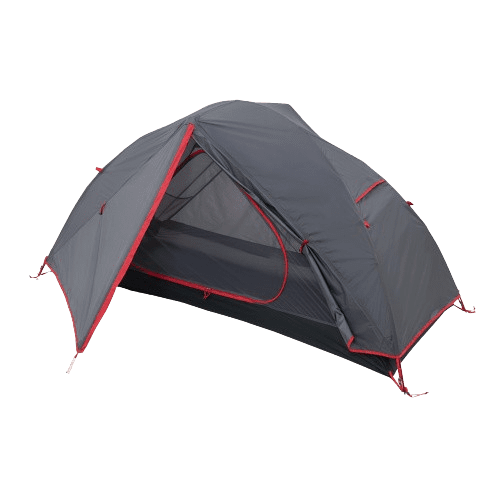ALPS Mountaineering Helix 1P Tent Review
 Don't forget to follow us on Instagram for the latest gear news!
Don't forget to follow us on Instagram for the latest gear news!
Welcome hikers, adventurers, and backpackers. I’m Karla Kennedy, a full-time guide with Wildland Trekking based in the Arizona area leading many of our guided Grand Canyon hiking trips. Quality gear is a prerequisite for effective guiding, and I need my gear to last me season after season without weighing me down. Among that essential gear, my tent is possibly the most important and difficult to dial in.
A good tent should be lightweight for hiking but still provide sufficient space to be comfortable with enough durability to handle whatever the backcountry throws at it. That’s a tricky balancing act, and I’ve certainly tried my fair share of tents over the years to try and find just the right one to support my guiding career. Therefore, I was excited to accept the opportunity to test the Helix 1-person Tent from ALPS Mountaineering. This review will detail my experience testing this tent along with my takeaways regarding the tent’s performance in the backcountry. So, let’s take a look!
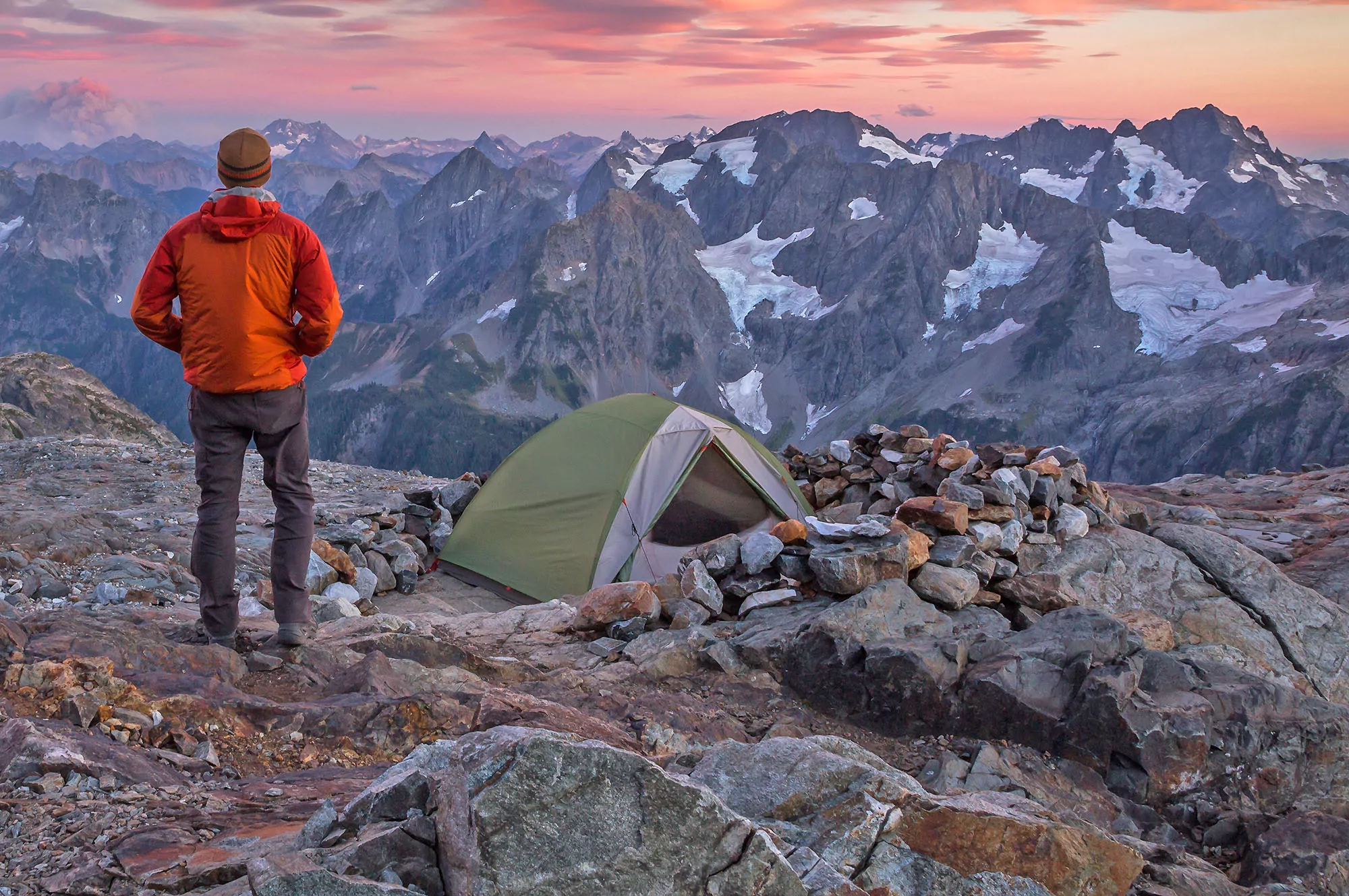
ALPS Helix 1P Quick Look
Let’s look at the Helix 1P Tent’s basic specifications to establish a foundation on which to build our review.
- MSRP: $219.00
- Trail Weight: 2lbs 14 oz
- Packaged Weight: 3 lbs. 3 oz.
- Peak Height: 3’1″ (37 inches)
- Floor Area: 20 sq. Ft.
- Floor Fabric: 20D ripstop nylon w/ 3000 mm silicone/pu coating
Intended Use
The Alps Helix 1P is designed to be the go-to backcountry tent for solo adventurers. The weight is competitive at 3 lbs 3 oz. and similar to other brands’ 1-person lightweight tents, while the interior offers decent storage with four pockets and good living space. Therefore, this tent isn’t a minimalist mummy tent that cuts significant space and features to lower the weight as much as humanely possible. Instead, this tent aims to maintain a comfortable living space and headroom with some basic amenities (such as a covered vestibule) while still trying to keep the overall weight low enough for high-mileage hiking so you can move light and fast.
ALPS HELIX Notable Features
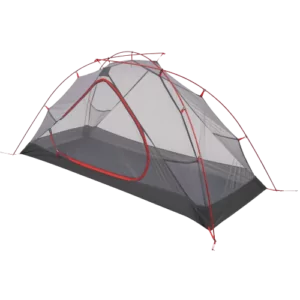
There are several features that make the Helix Tent stand out. We’ll look at these design characteristics below and how they impact the tent’s performance.
- Ultralight Design –keeps bulk and weight down, preventing the tent from taking up too much space in your pack or weighing you down.
- 3-Pole Frame – increases headroom while decreasing excessive bulk. Setup takes some getting used to, which we will discuss below.
- Rectangle Design – provides consistent space without tapering at the feet, allowing for a more comfortable living space with additional storage capacity.
ALPS MOUNTAINEERING Background
ALPS Mountaineering established itself in 1993 as a purveyor of high-quality hiking and mountaineering gear. The brand collaborated with icons in that particular industry, including Sir Edmund Hillary, to develop innovative solutions to the classic problems faced in the backcountry centering around weight, durability, and weatherproofing. ALPS Mountaineering founder, Dennis Brune, also gained experience at Kelty – another well-respected outdoors brand – before moving on to his own aspirations of developing cutting-edge gear.
THE TEST – QUICK OVERVIEW
I tested this tent over the course of four Grand Canyon Rim to Rim trips spanning from July to August, so HOT conditions!
Daytime temperatures during my testing generally peaked around 105ºF and dropped to the 70s at night, and maybe down to 65ºF if we were lucky. We encountered consistently rocky conditions for camping (shocker, right?) and minimal wind and precipitation.
Due to the high heat and minimal rain, I consistently camped without the rainfly attached to the tent. This affected how much information I could gather regarding weatherproofing, which we'll discuss below.
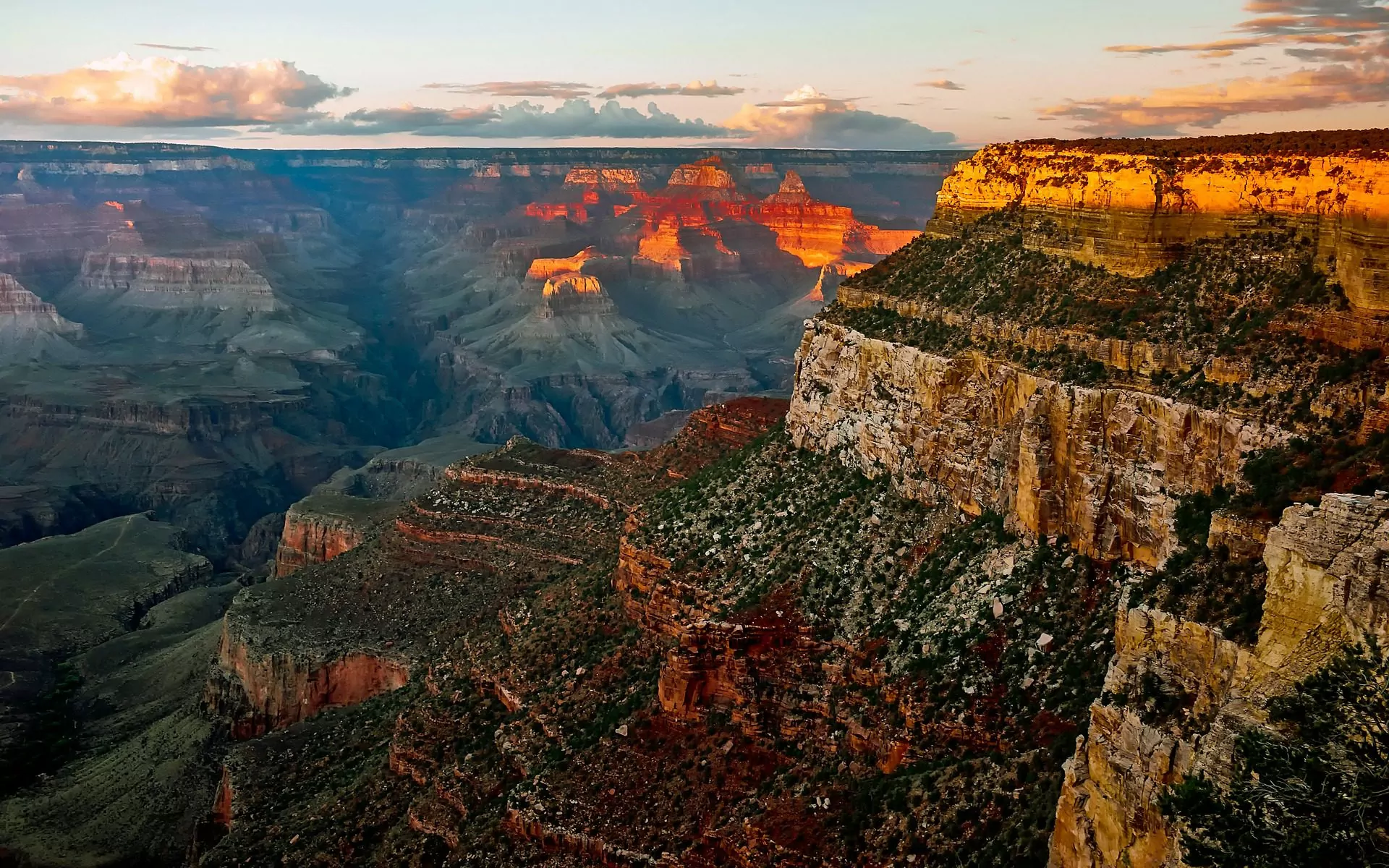
The Review
So, we’ve covered the basic details of the ALPS Helix 1P tent, some background information on ALPS Mountaineering, and the key features that set this particular tent apart in a very competitive field. That means it’s now time to dive into the full review. I’ll cover important tent characteristics below (durability, weight, and so on) and give each characteristic a score from 1 to 5. The key for these scores is below, and I’ll go into detail regarding why I assigned each particular score. Let’s get started!
Rating Key:
1/5 = Poor
2/5 = Tolerable
3/5 = Fair
4/5 = Good
5/5 = Excellent
Tent Weight/Bulk – 5/5
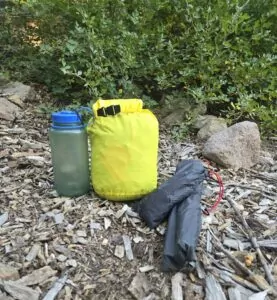
I was very pleased with the Helix’s low-weight design. At a hair over 3 lbs as packaged and 2 lbs 14 oz. as the trail weight (the tent weight without stakes or other non-essentials), this tent is nearly the exact same weight as my other go-to Nemo tent for guiding.
Therefore, the tent is competitive and comparable to other low-weight 1-person tents on the market. What’s more, the material and design choices eliminate excess bulk and allow the tent to pack down very small.
For a visual of this packability, take a look at the picture to the right. I use my own stuff sack instead of the included ALPS one, but the packed size compared to the Nalgene bottle is unmistakable. It’s only a little larger than the Nalgene! Meaning it takes minimal space in my pack and doesn’t weigh me down on the trail.
Setup – 2/5
For me, the setup for the Helix is its Achilles heel. Honestly, I HATED setting this tent up. It has a 3-pole system comprised of 1 whole pole and 2 half poles. When fully set up, all the poles work with and against each other to keep the tent up, but actually getting all the poles correctly inserted is a pain. You insert the long pole first, then attach the first half pole, which makes the tent twist on itself (center picture below), and then you have to drop it all onto the ground to get the other half pole inserted. This, in turn, makes the mesh of the tent hit the dirt/mud/sand. Once the second half pole is inserted, the whole tent stands on its own. Overall, I MUCH prefer tents that have 2 whole poles – especially when those poles are connected all together so you can hook everything up, and the mesh never hits the ground.
Also, the color coding of the tents leaves much to be desired. Red is not a good color for the color blind. The silver tip on the one whole pole is not easily seen (especially in low light or while using a red headlamp). Also, finding the two small hooks that belong to those aforementioned 2 half poles is not easy because they are also red in a sea of red (I would suggest using a totally different color on those so that they are easily distinguished from the other hooks).
Lastly, The hooks that hold onto 2 poles at once (two of these hooks) need to be upgraded so they actually hold onto those 2 poles well since one pole kept falling out, which further disrupts the setup. This issue is pictured below in the lefthand picture.
Therefore, I had to assign a low score in this department since the setup doesn’t seem intuitive or straightforward.
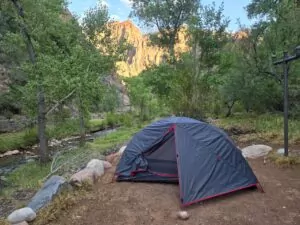
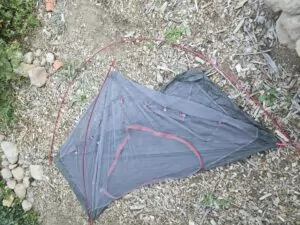
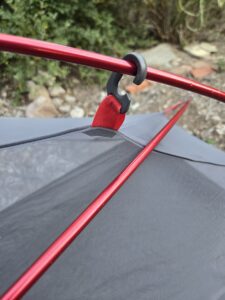
Durability – 4/5

Inside Living Space – 4/5
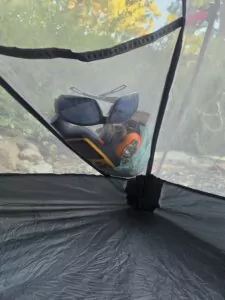
Overall, the Helix has a great interior. The headroom is impressive – I’m 5’10”, and could sit up with sufficient extra space to move around and change. Additionally, four interior storage pockets are a rare luxury in a lightweight tent, and I very much enjoyed the extra room to stash my gear.
Lastly, the rectangular shape is a simple but effective tool to make the inside extremely comfortable. Most ultralight tents opt for a tapered floor plan and narrow towards the foot of the tent. This tapering approach limits the overall living space, room to store gear, and space to move around. So, by maintaining a rectangular shape with no tapering, the Helix offers just a little bit more space than the competition, and I definitely noticed.
The subtracted point in this category is due to the tent length and vestibule size. In my opinion, the overall tent length was significantly short. My 5’10” self could sleep comfortably, but my feet grazed the mesh at the bottom of the tent, and there are definitely taller people in the world who would find this very constricting. Additionally, I found the vestibule area to be awkwardly shaped and small, barely … barely! … enough to protect my pack from the elements, and certainly not any additional gear I’d like to have out and accessible.
In conclusion, this is not a critique but an observation; I liked the hook at the apex but would like to see 3 or 4 more fabric loops at other points in the ceiling so I could rig up a small piece of cord to hang wet items inside the tent.
Weatherproofing – TBD
Overall Quality – 4/5
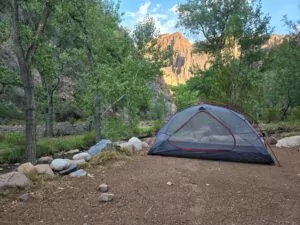
Zooming out to examine the tent materials and construction as a whole, my testing yielded all good results. The 20D ripstop nylon used for the floor and fly handled the rough and rocky terrain very well yet didn’t weigh me down, and the mesh canopy held up well during testing.
As I mentioned earlier, the zipper mechanism seems robust and easy to use. But I’m still very wary of the door design and setup process as both can cause the mesh canopy to come into contact with the ground, which has the potential to cause premature wear and tear, along with being an added hassle (especially if you’re trying to set up quickly in the rain on damp ground).
Price – 5/5
After comparing the Helix to other similar 1-person tents on the market, I have to say that the $219.00 price tag is excellent. For the value, quality, and features received, this price is extremely reasonable and noticeably lower than similarly sized alternatives. While some other options may offer more features or a better-designed setup method, I think this is right in the range for an effective yet affordable 1-person tent. It comes from a reputable company, and ALPS Mountaineering does have a warranty and spare parts program to keep their gear in the field as long as possible.
Bringing It Together
We’ve talked about many aspects of the Helix 1P Tent from ALPS Mountaineering. So, let’s take a moment to compile and review all the characteristics and performance aspects that we’ve discussed up to this point. Below, I’ve summed up all the pros and cons of this tent for us to look over.
Pros:
- Low weight
- Extremely packable
- Great quality
- Reasonably spacious interior with good stash pockets
- Good price
Cons:
- Ponderous and non-intuitive setup process
- Door design allows the door flap to fall to the ground (possible mechanism for damage)
Final Thoughts
In short, I found the ALPS Mountaineering Helix 1P Tent to be sturdy, spacious, and lightweight, but it still needs a little fine-tuning to truly become a backcountry powerhouse.
Specifically, the materials proved to be durable and high quality, while the interior living space seemed extra spacious with good stash pockets while still managing to stay competitively lightweight. The whole tent also packs down super small for minimal bulk in my backpack and easy transportation. The price is also excellent and very competitive, making the Helix an accessible and reliable option for backpackers.
However, I found that the overall setup process needs some refining before it becomes effective. The three-pole design (1 full pole and 2 half poles) definitely helps trim weight and bulk, but the resulting setup process results in some higgledy-piggledy as the tent twists one way and then another as the poles are inserted, resulting in the mesh canopy inevitably falling into the dirt, which is an obvious method for damage. The door zipper is also in need of the same refining since the door simply collapses into the dirt (or inside the tent, if you’re careful) when unzipped.
So great bones, a good floorplan, and a competitive price all wrapped in a lightweight envelope, but it just needs some refining around the edges for setup, and then the Helix 1P will truly be an outstanding tent.





